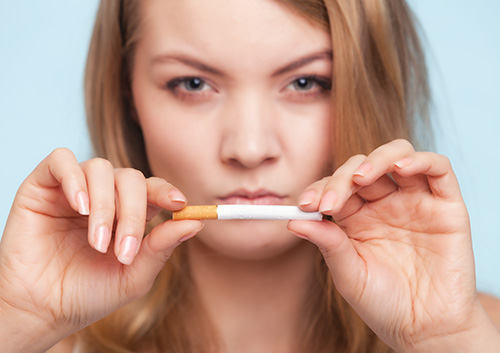January 22nd, 2020

Why does gum disease develop? Our mouths are home to bacteria, which form a film called plaque. Plaque sticks to the surfaces of our teeth, at the gumline, and can even grow below the gumline. And this bacterial growth leads to inflammation and gum disease.
When the disease progresses, the gums gradually pull away from the teeth leaving pockets which can be home to infection. Toxins can attack the bone structures and connective tissue, which support our teeth. Left untreated, periodontal disease can lead to serious infection and even tooth loss.
Because we are dealing with bacteria, it makes sense that antibiotics are one way to combat gum disease. Depending on the condition of your gums, we might suggest one of the following treatments:
- Mouthwashes—there are mouthwashes available with a prescription that are stronger than over-the-counter antibiotic formulas, and can be used after brushing and flossing.
- Topical Ointments—These ointments or gels are applied directly to the gums, most often used for mild forms of the disease.
- Time-release Treatments—If there is severe inflammation in a pocket, we might place a biodegradable powder, chip, or gel containing antibiotics directly in the affected area. These minute methods release antibiotics over a period of time as they dissolve.
- Pills and Capsules—For more serious periodontal disease, you could be prescribed an oral antibiotic. Take in pill or capsule form as recommended, and always finish the entire prescription.
Talk to Dr. Timm at our Michigan Center, MI office before beginning a course of antibiotics. It’s important to know if you have any allergies to medications, what to look for if you might have an allergy you didn’t know about, if you are pregnant or breast-feeding, or if you have any health concerns that would prohibit antibiotic use. Talk to us about possible side effects and how to use the medication most successfully. With proper treatment, we can treat gum disease as quickly and effectively as possible, and provide advice on maintaining a periodontal routine that will keep your gums and teeth healthy for years to come.
January 15th, 2020

Sometimes people feel a tiny bit nervous when they sit in the dental chair. And sometimes it’s more than a tiny bit. If your anxiety over visiting the office leads you to skip regular checkups and cleanings, or, worse, if you would rather suffer tooth or gum pain than give us a call—give our Michigan Center, MI office a call! Sedation dentistry might be just the procedure you need to make dental anxiety a thing of the past.
Dr. Timm and our team are trained to administer sedation and to monitor your responses throughout. And we want you to have all the information you need to decide on any dental treatment, including sedation. We will tell you of any risks, and describe the procedure in detail. If you have any health conditions or take any medications that might interfere with sedation, we can discuss your options with you and your doctor to make sure you are a good candidate. We will explain any preparations you should take, and let you know if there is a window of recovery time needed in our office while the sedation wears off.
Don’t let yourself suffer dental pain because you suffer from dental anxiety! Please call us to discuss sedation. We are trained to administer the treatment you choose gently and safely. Above all, we want to help you keep your smile the heathiest it can be, and that only happens when you have regular dental care. Let us work with you to make that care as comfortable and stress-free as possible.
January 8th, 2020

By now, everyone knows that smoking is bad for you. But the truth is its broad-reaching health effects are not all known by everyone. This is especially true of oral health. Smoking can have serious repercussions in this regard. To give you a better idea of how smoking can affect your oral health, Dr. Timm and our team have listed some issues that can arise.
Oral Cancer
Oral cancer can have steep ramifications for anyone that gets it. Surgery can be required to eliminate the cancer before it spreads to more vital parts of your body. Any type of cancer is about the worst health effect you can get, and this especially holds true to the affects that smoking has on your mouth. The type of mouth surgery required with oral cancer can leave your face deconstructed in certain areas, and it is all due to smoking or use of other tobacco products.
Tooth Discoloration and Bad Breath
At the very least, it is fair to say that as a smoker you will often have bad breath, and while you may try to cover it up with gum or mints, tooth discoloration is a whole other story. The chemicals and substances in cigarettes stick to your teeth staining them brown and yellow colors that are increasingly difficult to disguise.
Gum Disease and Loss of Bone
Another effect of smoking is the increased risk of gum disease. Your gums may start to recede, which can eventually lead to the loss of teeth. Smoking can also increase bone loss and density in your jaw which is vital to the health of your mouth. Gum disease and bone loss are two signs that smoking is definitely bad for your mouth.
When it comes to the health of your mouth, the question is not whether smoking affects your health, it's how does it affect your health and to what degree. If for no other reason than because smoking involves your mouth as its entry point, it is safe to say that it can have long-lasting and detrimental consequences on your oral health.
To learn more about smoking and your oral health, contact our Michigan Center, MI office to schedule an appointment with Dr. Timm.
January 1st, 2020

The beginning of a new year is the perfect opportunity for a fresh start for you and your smile. At Blue Spruce Dental, a brighter smile is quick and easy!
Given the latest in whitening technology, whiter teeth are only an appointment away. Teeth whitening is a safe, quick, and inexpensive way to create the dream smile you’ve always desired. We can offer a safe method that corrects tooth discolorations that may have been caused by staining, aging, or chemical effects.
So, start the new year off right and get a whiter smile today! Give us a call at our convenient Michigan Center, MI office to schedule an appointment!




